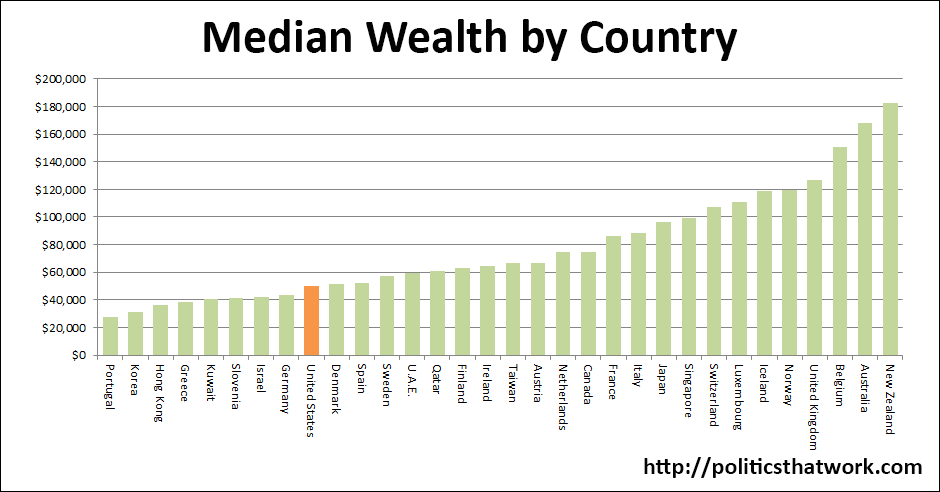
The Middle Classes of Twenty Three Countries Are Wealthier Than They Are in the United States
Description: This graph shows the median individual level of wealth of adults in the 32 wealthiest countries. Note, that the median wealth is the amount of wealth held by the person at the 50th percentile, which is distinct from the average amount of wealth.
Sources: Credit Suisse
Data: Excel
Last updated: May 12, 2016
Related blog post: Inequality in America
Discussion: The United States ranks 24th for median wealth. This is remarkable because the U.S. ranks 3rd for average wealth after Switzerland and New Zealand. The U.S. has an average wealth of $352,996, but a median wealth of only $49,787. This extraordinary deviation is a function of the extreme wealth inequality in the United States. The U.S.'s wealth is more concentrated than the wealth of any other country that tracks the distribution of wealth.
The wealth has been rapidly becoming more concentrated in the U.S. since the mid-1980s. It is currently more extreme than it has been since before the New Deal. That shift has largely been caused by virtually all wealth gains since 1980 being concentrated in the top 0.1% and even the top 0.01%.
Income inequality has risen under both parties since 1980. Top quintile incomes have risen much faster than the incomes of the other quintiles when Democrats have been in the White House. However, under Republican presidents, the incomes of the bottom 3/5 of the population have actually fallen. When the party that controls the legislature is taken into account, the pattern is much starker- middle class incomes have fared far better under Democratic leadership ever since 1930.
Economic equality correlates strongly with the percentage of social spending that is driven through the public sector. Countries that rely heavily on private mechanisms to pay for things like education and healthcare, like the United States does, tend to have much higher inequality. The weakening of collective bargaining has also played a significant role because it has enabled employers to keep the lion's share of workers' productivity.
See more graphs about: Wealth
Discussion: The United States ranks 24th for median wealth. This is remarkable because the U.S. ranks 3rd for average wealth after Switzerland and New Zealand. The U.S. has an average wealth of $352,996, but a median wealth of only $49,787. This extraordinary deviation is a function of the extreme wealth inequality in the United States. The U.S.'s wealth is more concentrated than the wealth of any other country that tracks the distribution of wealth.
The wealth has been rapidly becoming more concentrated in the U.S. since the mid-1980s. It is currently more extreme than it has been since before the New Deal. That shift has largely been caused by virtually all wealth gains since 1980 being concentrated in the top 0.1% and even the top 0.01%.
Income inequality has risen under both parties since 1980. Top quintile incomes have risen much faster than the incomes of the other quintiles when Democrats have been in the White House. However, under Republican presidents, the incomes of the bottom 3/5 of the population have actually fallen. When the party that controls the legislature is taken into account, the pattern is much starker- middle class incomes have fared far better under Democratic leadership ever since 1930.
Economic equality correlates strongly with the percentage of social spending that is driven through the public sector. Countries that rely heavily on private mechanisms to pay for things like education and healthcare, like the United States does, tend to have much higher inequality. The weakening of collective bargaining has also played a significant role because it has enabled employers to keep the lion's share of workers' productivity.
See more graphs about: Wealth
Political and Economic News
EPI: The Tax Cuts and Jobs Act isn’t working and there’s no reason to think that will change
CNN: Trump ordered Mattis to screw Amazon
Elijah Cummings: We are in a fight for the soul of our democracy
Pro Market: The Cost of America’s Oligopoly Problem
...more





